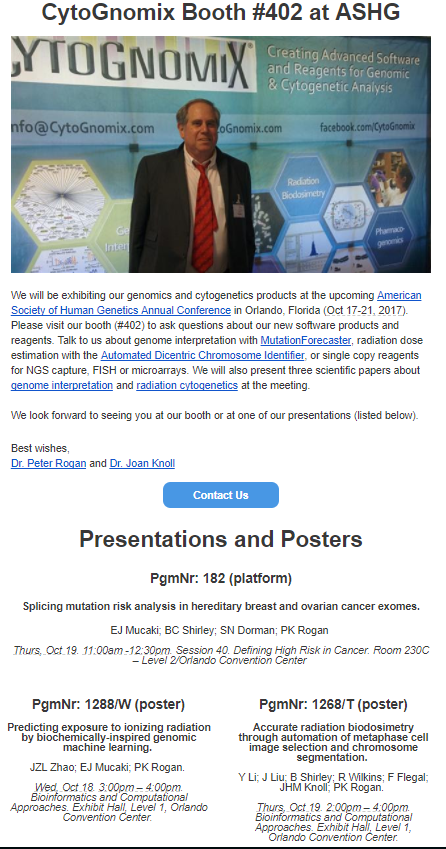NEWS RELEASE
For immediate release
Ontario company contributes to radiation biodosimetry project at the International Atomic Energy Agency
Cytognomix accelerates estimation of radiation exposure by participating institutions of International Atomic Energy Agency (IAEA) Member States
October 30, 2017 London, Ontario, Canada Cytognomix Inc
Calibration of radiation exposure needs to be accurate for effective cancer treatment. Treatment of radiation overexposures depends on precise measurement of absorbed dose and the type of radiation received. Quantification of radiation exposure by biodosimetry testing needs to be timely for patients to benefit.
The IAEA is committed to encouraging and assisting research on, and development of practical applications of atomic energy for peaceful uses throughout the world. It has extended the opportunity to research institutes in Member States to participate in the Coordinated Research Project (CRP) E35010 entitled ‘Applications of Biological Dosimetry Methods in Radiation Oncology, Nuclear Medicine, and Diagnostic and Interventional Radiology.’
The IAEA is sponsoring CytoGnomix’s Research Project, entitled ‘Determination of Radiation Exposure by Fully Automated Dicentric Chromosome Analysis.’ This project will enable laboratories and research institutions of Member States to use Cytognomix’s technology to accelerate testing radiation exposure.
In this project, Cytognomix Inc. will use its systems to automatically analyze digital images of chromosomes exposed to radiation to estimate exposure. Results obtained by biodosimetry laboratories at Health Canada and Canadian Nuclear Laboratories suggest that the results are similar to traditional manual analyses, but are achieved considerably more quickly. This research will expand access to these systems by other laboratories participating in IAEA’s Coordinated Research Project.
Accuracy and speed of the automated system will be compared with previous results from collaborating CRP laboratories that were obtained by manual or computer-assisted DCA scoring. It is anticipated that cell image data obtained from test samples in prior or current international joint laboratory exercises or independent assay validation activities will be reused in this study. Each collaborating laboratory will also receive a demonstration software version containing their calibration curve and test sample data. Dose estimates obtained by CytoGnomix will be compared with results obtained by collaborators. If the previous results are comparable to those obtained with ADCI in different laboratories, this will establish the feasibility of undertaking larger scale, batch analysis of populations of individuals that have potentially received radiation exposure. A unique aspect of the proposed study will assess whether it enables greater standardization of results obtained by different laboratories, because all labs will use a common algorithm to process their data, while still allowing different labs to customize their own calibration curves for determining unknown radiation exposures, which addresses differences in chromosome preparation methods and radiation calibration sources between labs.
Quotes
“The IAEA has recognized the critical need for faster approaches to accurately determine radiation exposure that address impending needs by its members. By sponsoring our project, CytoGnomix will have a unique opportunity to provide hands-on experiences to radiation biodosimetry laboratories and centres worldwide.”
Dr. Peter K. Rogan
President of Cytognomix Inc.
Quick facts
- Established in 2009, CytoGnomix Inc. is a biotechnology company that designs and markets advanced genomic reagents and software-based solutions. Its products personalize the diagnosis, evaluation and management of cancer, prenatal disorders and other genetic diseases.
- CytoGnomix’s ADCI software system selects high-quality cells from all types of digital images for analysis, identifies chromosome anomalies, builds biodosimetry calibration curves and estimates exposure in less than an hour.
- In 2017, IAEA is sponsoring 35 Cooperative Research Activities on diverse topics concerning the peaceful use of atomic energy. CRP E35010, which is focused on the biological effects of radiation, is one of 5 projects focused on human health. The decision to award a research contract or agreement is made after careful consideration of the technical merits of the proposal, the compatibility of the project with the IAEA’s own functions and approved programmes, the availability of appropriate facilities and personnel in the institution and previous research work related to the project. Where it is recognized that the award of a particular research or technical contract or research agreement would materially assist one of the IAEA’s programmes, an invitation is sent to those institutions believed to have the necessary facilities and personnel, and the Government of the Member State concerned is kept informed.
Associated links
CytoGnomix: company website; radiation biodosimetry website
Follow us on Facebook
IAEA: website
Follow us on Facebook
Contacts
Corporate Communications, CytoGnomix
(1) 519-661-4255
info@cytognomix.com


